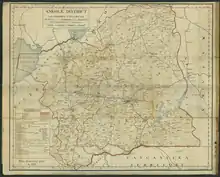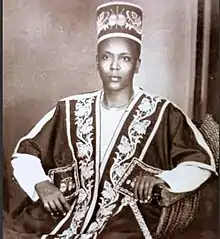Ankole
Ankole (Runyankore: Nkore), was a traditional Bantu kingdom in Uganda. The kingdom is located in south-western Uganda, east of Lake Edward. It was ruled by a monarch known as the Mugabe or Omugabe. The kingdom was formally abolished in 1967 by the government of President Milton Obote, and since then, the kingdom has not been restored officially.[2] The people of Ankole are called Banyankole (singular: Munyankole) in Runyankole language, a Bantu language.
Kingdom of Ankole Obugabe Bwa Ankore | |
|---|---|
| 1478–1967 | |
 Flag
 Coat of arms
| |
Anthem: 'Ensi Nkore, Ensi Nkore' | |
.png.webp) Location of Ankole (red) in Uganda (pink). | |
| Status | Kingdom |
| Capital | Mbarara[1] |
| Common languages | Runyakole |
| Ethnic groups | Banyankole |
| Government | Constitutional monarchy |
• Omugabe | Prince Charles Rwebishengye |
• Enganzi | N/A |
| History | |
• Established | 1478 |
• Disestablished | 1967 |
| Area | |
• Total | 16,104 km2 (6,218 sq mi) |
| Population | |
• Estimate | 4.1 Million |
| Currency | Uganda Shillings (UGX) |
| Time zone | UTC+3 (EAT) |
| Calling code | 256 |
On 25 October 1901, the Kingdom of Nkore was incorporated into the British Protectorate of Uganda by the signing of the Ankole agreement.[3]
Because of the reorganisation of the country by Idi Amin, Ankole no longer exists as an administrative unit. It is divided into ten districts, namely: Bushenyi District, Buhweju District, Mitooma District, Rubirizi District, Sheema District, Ntungamo District, Mbarara District, Kiruhura District, Ibanda District, and Isingiro District.
Location

Ankole Kingdom is located in the South-Western region of Uganda bordering Rwanda and the Democratic Republic of Congo
List of Omugabe of Ankole

- Ruhinda, late fifteenth century
- Nkuba, late fifteenth century
- Nyaika, early sixteenth century
- Ntare I, mid sixteenth century
- Rushango, late sixteenth century
- Ntare II, late sixteenth century/early seventeenth century
- Ntare III, mid seventeenth century
- Kasasira, late seventeenth century
- Kitra, late seventeenth century
- Rumongye, late seventeenth century
- Mirindi, late seventeenth century
- Ntare IV, c. 1699–c. 1727
- Macwa, c. 1727–c. 1755
- Rwabirere, c. 1755–1783
- Kahaya I, 1783–?
- Rwebishengye, ?–1811
- Kayungu, 1811–?
- Gasyonga I, ?–1839
- Mutambuka, 1839–1873
- Ntare V Rugingiza, 1873–1895
- Kahaya II, 1895–1944
- Gasyonga II, 1944–1967
- Monarchy discontinued by the Ugandan government, 1967–present
- Ntare VI/John Barigye, 1993–2011 (Titular king)
- Charles Rwebishengye, 2011–present (Titular king/crown prince)
Nkole people
Nkole people are a Bantu ethnic group native to Uganda. They primarily inhabit Ankole. They are closely related to other Bantu peoples of the region, namely the Nyoro, Kiga, Toro and Hema peoples. Their population is 4,187,445(9.8% of Uganda). There are several names they are referred to as. These include the following ones: Ankole, Ankori, Banyankole, Banyankore, Nkoles, Nkore, Nyankole, Nyankore, Ouanyankori, Runyankole, Runyankore, Uluyankole, Uluyankore. The Nkole speak Orunyankore, a Great Lakes Bantu language. There were an estimated 2.3 million native speakers in 2002.
Ankole history
Bairu and Bahima clans
Banyankore trace their ancestors back to two different ethnic groups, the Bairu-mainly agriculturalists and the Bahima subgroup-mainly pastoralists. Both groups migrated from central Africa to what is now Uganda between the years 500 and 1000AD. The two groups formed a relationship based on trade. The Bahima, although smaller in number than the Bairu, were socially dominant as they only, owned cattle. However, this relationship has enormously changed and today, cattle rearing and agricultural practice is done by both the Bairu and Bahima. The two groups formed the Ankole (also referred to as Nkole/ Nkore) kingdom in present-day western Uganda. Originally, Ankole was known as Kaaro-Karungi and the word Nkore is said to have been adopted during the 17th century following the devastating invasion of Kaaro-Karungi by Chawaali, the then Omukama of Bunyoro-Kitara. The word Ankole was introduced by British colonial administrators to describe the bigger kingdom which was formed by adding to the original Nkore, the former independent kingdoms of Igara, Sheema, Buhweju and parts of Mpororo (Runyankore is native language in these areas). Ankole kingdom was one of four kingdoms that make up what is now Uganda. The ruler of the kingdom was called Omugabe. Below the Omugabe was a prime minister called Enganzi and local chiefs known as Abakuru b’ebyanga. The Banyankore traditional social structure emphasized clan loyalty as opposed to a central government scheme. Banyankore traditionally lived in villages and practiced both migratory animal husbandry and subsistence farming with a shift to an emphasis on cash crops such as coffee and cotton in contemporary times. Since Uganda was colonized by the British, it has been difficult for them to reinstate their form of traditional government.[4]
Kingdom abolished
The kingdom was formally abolished in 1967 by Ugandan government under president Apollo Milton Obote and has not been restored since.
Origins of the Banyakole
Like other Bantu groups, the origins of the Banyankore could be traced to the Congo region. Legends hold that the first occupant of Ankole was Ruhanga (the creator), who is believed to have come from heaven to rule the earth. Ruhanga is believed to have come with his three sons Kairu, Kakama and Kahima. There is a popular legendary story about how Ruhanga gave a test to determine which of his sons would become the heir. The test is said to have been that of keeping milk–filled pots on their laps throughout the night. At the end of it all, the youngest son, Kakama, is said to have passed the test followed by Kahima and last came the eldest son, Kairu. Judging from the performance in the test, Ruhanga is said to have decreed that Kairu and Kahima would serve their brother Kakama. Thereafter he went back to heaven, leaving Kakama or Ruhanga, as he was also called, to rule the land.
Counties of Nkole (Amashaza)
Nkore Kingdom was divided into ten counties. These counties are now divided into various political constituencies. But the original ten counties of Nkore include:
Nkole calendar

The Nkore calendar was divided into 12 months. They were named according to weather conditions and activities done in that period. They include:
- Biruuru
- Kaatambuga
- Katumba
- Nyeikoma
- Kyabahezi
- Kahingo
- Nyeirurwe
- Kamena
- Kicuransi
- Kashwa
- Museenene
- Muzimbezi
References
- Briggs, Philip; Roberts, Andrew (5 November 2016). Uganda. Bradt Travel Guides. p. 534. ISBN 9781784770228. Retrieved 29 December 2016.
- The Observer Media Ltd. :: The Weekly Observer :: Uganda's Top Resource site Archived 3 December 2007 at the Wayback Machine
- The Ankole Agreement 1901
- "Runyakore History and Culture" (PDF). Runyakore L&C. 1/26/21. Check date values in:
|date=(help)
